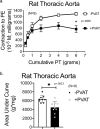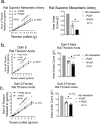A New Function for Perivascular Adipose Tissue (PVAT): Assistance of Arterial Stress Relaxation
- PMID: 32019956
- PMCID: PMC7000722
- DOI: 10.1038/s41598-020-58368-x
A New Function for Perivascular Adipose Tissue (PVAT): Assistance of Arterial Stress Relaxation
Abstract
In health, PVAT secretes anti-contractile factors that relax the underlying artery. PVAT's contributions to vascular function include more than production of vasoactive substances. We hypothesized that PVAT benefits the artery by assisting the function of stress (-induced) relaxation. Thoracic aorta rings from Sprague Dawley rats were mounted in isolated tissue baths with (+) and without (-) PVAT. A cumulative length tension (0-6 grams) was generated. The tension to which the tissue stress relaxed over 30 minutes was recorded; the tension lost was stress relaxation. The presence of PVAT increased the amount of stress relaxation (final tension in mgs; aortic ring -PVAT = 4578 ± 190; aortic ring + PVAT = 2730 ± 274, p < 0.05). PVAT left attached but not encompassing the aorta provided no benefit in cumulative stress relaxation (aortic ring +/- PVAT = 4122 ± 176; p > 0.05 vs -PVAT). A PVAT ring separated from the aorta demonstrated more profound stress relaxation than did the aortic ring itself. Finally, PVAT-assisted stress relaxation was observed in an artery with white fat (superior mesenteric artery) and in aorta from both male and female of another rat strain, the Dahl S rat. Knowledge of this new PVAT function supports PVAT as an essential player in vascular health.
Conflict of interest statement
The authors declare no competing interests.
Figures






Similar articles
-
Aortic stiffness is lower when PVAT is included: a novel ex vivo mechanics study.Am J Physiol Heart Circ Physiol. 2022 Jun 1;322(6):H1003-H1013. doi: 10.1152/ajpheart.00574.2021. Epub 2022 Mar 11. Am J Physiol Heart Circ Physiol. 2022. PMID: 35275760 Free PMC article.
-
Identification of Piezo1 channels in perivascular adipose tissue (PVAT) and their potential role in vascular function.Pharmacol Res. 2022 Jan;175:105995. doi: 10.1016/j.phrs.2021.105995. Epub 2021 Nov 21. Pharmacol Res. 2022. PMID: 34818570 Free PMC article.
-
Male and female high-fat diet-fed Dahl SS rats are largely protected from vascular dysfunctions: PVAT contributions reveal sex differences.Am J Physiol Heart Circ Physiol. 2021 Jul 1;321(1):H15-H28. doi: 10.1152/ajpheart.00131.2021. Epub 2021 Apr 30. Am J Physiol Heart Circ Physiol. 2021. PMID: 33929898 Free PMC article.
-
Dual modulation of vascular function by perivascular adipose tissue and its potential correlation with adiposity/lipoatrophy-related vascular dysfunction.Curr Pharm Des. 2007;13(21):2185-92. doi: 10.2174/138161207781039634. Curr Pharm Des. 2007. PMID: 17627551 Review.
-
New actions of an old friend: perivascular adipose tissue's adrenergic mechanisms.Br J Pharmacol. 2017 Oct;174(20):3454-3465. doi: 10.1111/bph.13663. Epub 2016 Dec 4. Br J Pharmacol. 2017. PMID: 27813085 Free PMC article. Review.
Cited by
-
Platelets Modulate Leukocyte Population Composition Within Perivascular Adipose Tissue.Int J Mol Sci. 2025 Feb 14;26(4):1625. doi: 10.3390/ijms26041625. Int J Mol Sci. 2025. PMID: 40004089 Free PMC article.
-
Obesity, Cardiovascular and Neurodegenerative Diseases: Potential Common Mechanisms.Physiol Res. 2023 Jul 31;72(Suppl 2):S73-S90. doi: 10.33549/physiolres.935109. Physiol Res. 2023. PMID: 37565414 Free PMC article. Review.
-
Mechanotransduction in the Perivascular Adipose Tissue.Arterioscler Thromb Vasc Biol. 2025 Apr;45(4):461-467. doi: 10.1161/ATVBAHA.124.321688. Epub 2025 Feb 13. Arterioscler Thromb Vasc Biol. 2025. PMID: 39945069 Review.
-
Obesity, Adipose Tissue and Vascular Dysfunction.Circ Res. 2021 Apr 2;128(7):951-968. doi: 10.1161/CIRCRESAHA.121.318093. Epub 2021 Apr 1. Circ Res. 2021. PMID: 33793327 Free PMC article. Review.
-
Guidelines for the measurement of vascular function and structure in isolated arteries and veins.Am J Physiol Heart Circ Physiol. 2021 Jul 1;321(1):H77-H111. doi: 10.1152/ajpheart.01021.2020. Epub 2021 May 14. Am J Physiol Heart Circ Physiol. 2021. PMID: 33989082 Free PMC article. Review.
References
-
- Soltis EE, Cassis LA. Influence of perivascular adipose tissue on rat aortic smooth muscle responsiveness. Clin. Exp. Hypertens. A. 1991;13:277–296. - PubMed
Publication types
MeSH terms
LinkOut - more resources
Full Text Sources

